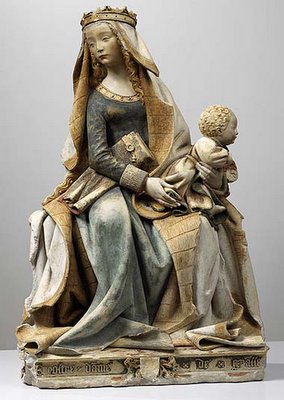Virgin and Child, Toulouse
 Toulouse has a good art museum, the Musée des Augustins, housed in a former Augustinian monastery. That institution has just restored two of its most glorious 15th-century works, an altarpiece and a portrait of the Virgin and Child, and an article by Anne-Marie Romero (L'indicible beauté d'une Vierge toulousaine, December 24) for Le Figaro has the goods (my translation):
Toulouse has a good art museum, the Musée des Augustins, housed in a former Augustinian monastery. That institution has just restored two of its most glorious 15th-century works, an altarpiece and a portrait of the Virgin and Child, and an article by Anne-Marie Romero (L'indicible beauté d'une Vierge toulousaine, December 24) for Le Figaro has the goods (my translation):
An emblematic sculpture of the Toulouse museum, even when the multiple repaintings it has suffered since the 15th century has made it into a mass of grayish and leprous stone, Nostre-Dame de Grasse can now be considered as "one of the most beautiful gothic Virgins in the world," as stated without exaggeration by Alain Daguerre de Hureaux, the museum's director. Along with an altarpiece of the crucifixion, made for the Toulouse Parliament, also restored, it is now in a didactic exhibit explaining the process of six years of combative work. About one meter high, sculpted in a fine limestone, Nostre-Dame de Grasse attains complete perfection: seated on a bench of carved stone, richly clothed in a gown of grayish squirrel fur and a cloak backed with golden fur, Mary adds to the sumptuousness of her attire, with its heavy folds, an unfashionable architecture and an admirable formal beauty.The colors have changed a lot over the centuries, and the Virgin's face has been altered in bizarre ways, adding dark eyebrows or blackening her eyes, for example. The other restored work is the rather striking Crucifixion du Parlement de Toulouse. Take a look at the excellent Web site for this exhibit, Polychromies secrètes, which has lots of information and images about the restoration. The show will be open to the public through April 30.
In effect, Virgins who turn their head to one side are rare, while the Baby Jesus -- blessed, for once, with a real nursling's face -- looks the other way. As for Mary's looks, gracious, young, marked with a sweet melancholy, framed by a voluptuous mass of golden curls, she is a very young girl whose beauty is both pure and sensual, already closer to the Renaissance than the International Gothic style in which she is often classed. French quattrocento, in a way.




















































2 comments:
The gray makes it beautiful, to me. Instead of the usual gaudy guilded look. Simple beauty.
Nice point, Mark. Take a look at the Web site to see what you think of the colors as they have been restored. I didn't get to this museum when I was in Toulouse, but I am going back some day to spend some time with this beautiful hunk of stone.
Post a Comment